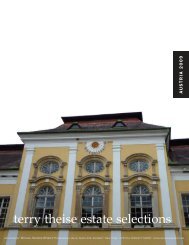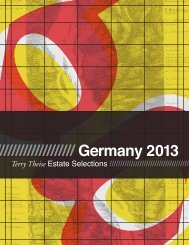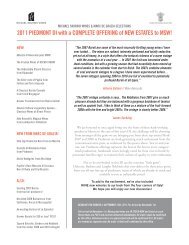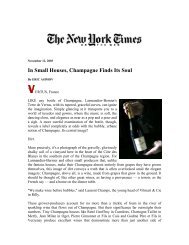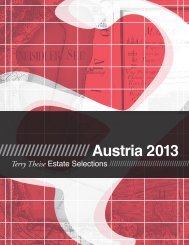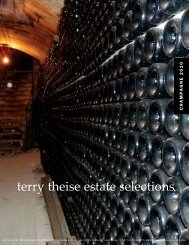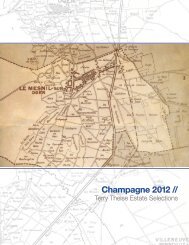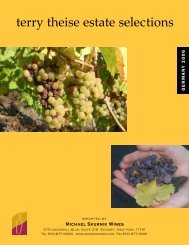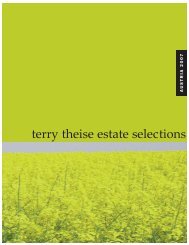View 2013 Champagne Catalog - Michael Skurnik Wines
View 2013 Champagne Catalog - Michael Skurnik Wines
View 2013 Champagne Catalog - Michael Skurnik Wines
Create successful ePaper yourself
Turn your PDF publications into a flip-book with our unique Google optimized e-Paper software.
Pierre Gimonnet<br />
Côte des Blancs // Cuis<br />
vineyard area // 28 hectares<br />
annual production // 20,800 cases<br />
villages & soil types // Cramant Grand Cru, Chouilly Grand Cru, Oger Grand Cru,<br />
Aÿ Grand Cru, Mareuil sur Aÿ 1 er Cru (chalk); Cuis 1 er Cru (chalk and clay)<br />
grape varieties // 98% Chardonnay, 2% Pinot Noir<br />
Côte des Blancs<br />
Pierre Gimonnet<br />
Didier is proof that you can’t just let the cat’s whiskers out of the bag; if any part of<br />
the cat gets out she all gets out.<br />
First he breached his 100% Chardonnay rule with<br />
the scandalous Paradoxe, which contained the alien Pinot<br />
Noir. And now, heaven help us, he has a Rosé. And even<br />
more amazing, this man who has always insisted that<br />
blending is indispensible to creating elegant <strong>Champagne</strong>s,<br />
is now planning a trilogy of single-commune wines from<br />
the outstanding 2012 vintage. Chouilly, Oger, Cramant;<br />
maybe just this once, he says. Uh huh!<br />
Gimonnet’s is a polished domaine as small-growers<br />
go, with his 28 hectares, the most in the Côte des Blancs.<br />
He’s renovated his reception area, and you can now taste<br />
as the delicate ladies and gentlemen I know you to be.<br />
It is, dare I say, elegant. But then Didier wants to find<br />
some piece of information about a harvest gone by, and<br />
instead of pulling it up on his up-to-the-minute I-Pad<br />
(nowhere to be seen, in fact) he pulls it from a decidedly<br />
ratty pocket-sized little notebook, where all the data are<br />
scribbled by hand. This I just love.<br />
After seven years of tasting vins clairs with<br />
Gimonnet, I’m beginning to grok his thinking about<br />
these “ingredients” in his pantry. I’m also better able to<br />
understand his cognitive unease at the new alien terroirs<br />
with which he has to work, in Oger and Vertus. They<br />
don’t fit in the existing recipes. So either those recipes<br />
must change, or new recipes created.<br />
The wines of Cuis, especially from the climat “Croix<br />
Blanche,” are fresh and redolent of fruits and flowers,<br />
especially quince and peonies. They give a lively femininity<br />
to a cuvée, and often are viable on their own, as wines.<br />
Didier feels that a certain amount of Cuis is indispensable<br />
to his style, even though it costs him the Grand Cru<br />
designation in many instances. That’s integrity.<br />
Chouilly I admit I find obscure. It shows very little<br />
fruit as-such. Instead there’s a berried tartness and a<br />
serious spine of structure alongside an indirect minerality.<br />
The climat “Mont Aigu,” down on the plain, “smells like<br />
Gimonnet” according to... Gimonnet! The very old parcel<br />
in neighboring “Fond du Bateau” (planted in 1911) often<br />
recalls Grüner Veltliner in its forceful char.<br />
Its neighbor just across the Cramant line is called “Les<br />
Gromonts.” Suddenly there are flowers and quince again,<br />
along with a tactile crushed minerality. Who knows why<br />
they put the commune line just there, when we all know<br />
terroir is a hoax…. Cramant in general is the Riesling<br />
lover’s Chardonnay. “Buissant” is open and tangy; other<br />
climates echo Riesling at its greenest and most iridescent.<br />
Gimonnet at a glance // 28-hectare winery, therefore enough wine, which is good because it is VERY BEAUTIFUL<br />
WINE with great class and savor. And sensible prices!<br />
how the wines taste // The wines are suave, creamy and refined, with a “soft”minerality dispersed through<br />
the fruit. Silky, stylish wines rather than vigorous, racy wines. These are very deliciously accommodating to<br />
the palate. Old vines impart a palpable creaminess. The majority of Gimonnet’s vineyards are more than 40<br />
years old, the oldest parcel (in Cramant) is 100. The wines tolerate a very low dosage, 6-8 grams per liter for<br />
most Bruts. “For me, we must have concentration, but also balance, elegance and harmony,” says Didier.<br />
This is more than just word-wash for him. He’s constantly challenged by callow journalists for his views on yields<br />
and ripeness. And he goes on making his lovely wines, which have all the density they need and no more. “In 2003<br />
we had, as you’ve surely heard, a great vintage,” he said. “And just as an experiment we left some grapes hanging<br />
three weeks after the end of the regular harvest. They achieved a potential alcohol of nearly 13% (T.T. here: 9-10% is<br />
considered normal) and we vinified them separately. Later, when we were tasting the lots for assemblage, we agreed<br />
unanimously, this wine was useless to us; it belonged nowhere. We ended up selling it off. It was heavy and clumsy.”<br />
6



